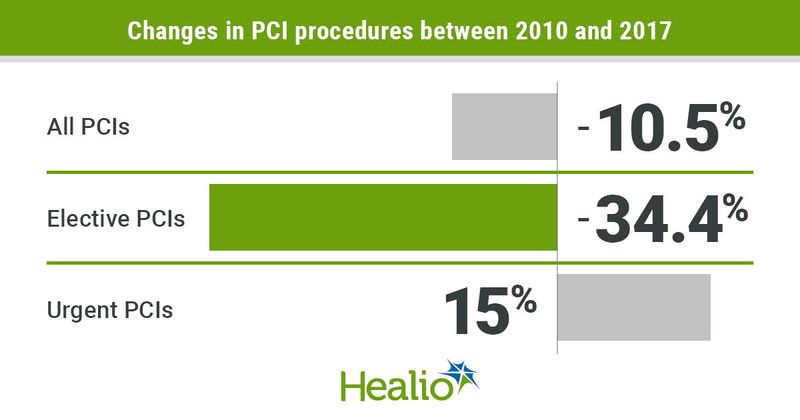PCI rates down 10% during 8-year period
After a significant decline in elective PCIs performed from 2010 to 2013, rates of the procedure remained stable through 2017, resulting in a roughly 10% decline in PCIs performed during the 8-year period, researchers reported.
“As we had hypothesized, the initial declines observed in elective PCIs following the COURAGE trial have leveled off,” Zaid I. Almarzooq, MBBCh, clinical fellow in medicine at Brigham and Women’s Hospital and Harvard Medical School, told Healio.

According to Almarzooq, studies evaluating PCI trends after the COURAGE trial had shown steep declines in PCI rates. “More recent studies have shown a continuation of that trend. However, these studies did not include outpatient PCIs, which constitute an increasing proportion of PCIs today,” he said. “This led us to investigate the question at hand using a cohort that better captures the full spectrum of U.S. patients undergoing PCI.”
The cohort was derived from the Healthcare Cost and Utilization Project (HCUP) State Inpatient Databases (SID) and State Ambulatory Surgery and Services Databases (SASD), which captured all procedures performed in nonfederal facilities. Almarzooq and colleagues identified patients who underwent PCI in Florida, Maryland, Michigan and New York from 2010 to 2017; these four states were chosen because of the availability of both data sets previously mentioned, which were integral in capturing inpatient and outpatient PCIs, the researchers wrote.
PCI procedures were defined as urgent if they were performed in the setting of an MI and elective if they were not.
Among the 333,819 patients (32% women; mean age, 66 years) included in the study, 1,044,698 PCIs were performed, of which 42.9% were urgent and 57.1% elective. Researchers noted a decline in PCI rates (10.5%; P for trend < .001) from 2010 to 2017, driven entirely by a decrease in elective PCIs (34.4%; P < .001); urgent PCIs, meanwhile, rose 15% (P < .001).
After a decrease in elective PCIs performed from 2010 to 2013 (23.8%; P < .001), PCI rates leveled off (1.9%; P = .496).
“These new levels likely reflect a more appropriate PCI rate given the growing evidence supporting the use of initial medical therapy, while we do acknowledge the importance of PCI as an effective treatment for MI and angina,” Almarzooq said in an interview.
In other data, inpatient PCI rates fell (26.6%; P < .001), whereas outpatient PCI rates increased 97.1% (P < .001).
The strong shift to the outpatient setting, Almarzooq said, “likely reflects the growing evidence on safety of same-day discharges after PCI and changes in incentives. It remains unknown, however, what the impact of more recent trials, such as ORBITA and ISCHEMIA, are on these trends.”
For more information:
Zaid I. Almarzooq, MBBCh, can be reached at zalmarzooq@bwh.harvard.edu; Twitter: @zaidalmarzooq.
